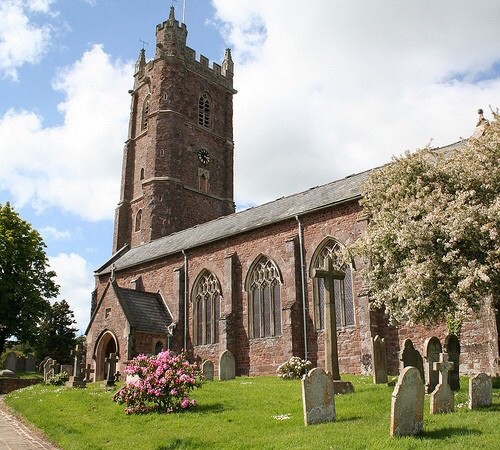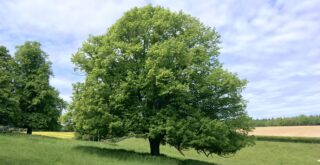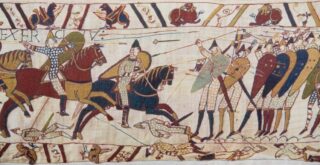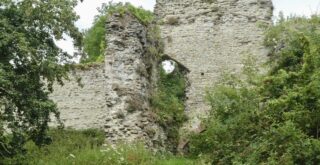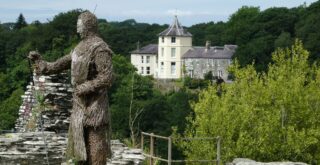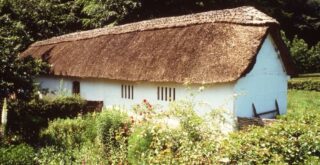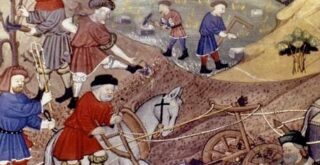Origins
The Mortimers appear to have settled in Bradninch at an early point, perhaps around the turn of the 15th century. They are unique among the Devonshire Mortimers in that they seem to have either used or claimed a coat of arms- the same used by the Wigmore Mortimers;

Mortimer coat of arms in stained glass
Barry of six or and azure an inescutcheon argent in chief a pale of the first between two gyrons of the second (Source: Devon and Cornwall Notes and Queries Vol. 6; p. 36). Right: The Mortimer coat of arms in stained glass at a different location
The first Mortimer of Bradninch may have died before 1524, leaving a widow, Elizabeth, who lived in Silverton. Unfortunately the name of this Mortimer is presently unknown but it may have been John, for his eldest grandson was also called John. English naming tradition was for the eldest to be named after his paternal grandfather. Often it would be the eldest son who would inherit land, meaning that popular first names would repeat down generations of the same family.
John? Mortimer of Bradninch seems to have been a well off yeoman and must have owned property in Bradninch. A birth year in the 1470s perhaps seems reasonable. He was presumably related to the Mortimers of Stockleigh English or Sandford, and may even have represented the senior branch of the family that goes back to John Mortimer of Stockleigh, c.1420-1470. Constructing the early generations of the Bradninch family is fraught with challenges however, due to the absence of supporting information from either wills or land records in the early 16th century. It is also unknown how the Mortimers of Bradninch relate to the Mortimers of Newton St Cyres, despite the geographical proximity.
Family tree
The above Mortimer of Bradninch senior, married Elizabeth, but died before 1524, leaving his wife property in Silverton. In the 1524 Lay subsidy Elizabeth Mortimer’s value was assessed at £3 in goods, making her eligible to pay the tax. Elizabeth appears to have died before the next tax assessment in 1543, by which time her son John Mortimer’s income in Bradninch had increased by the same amount, presumably inheriting her property. Together, (John?) and Elizabeth had the following sons in Bradninch:
- John Mortimer, presumably the eldest son, was probably born just before the 1500s. In 1524 he had an income of £7, slightly more than Richard Mortimer in the same parish. By 1543, he had presumably inherited his mother’s dower estate, increasing his income to £10. This gave him the income expected of a well off yeoman.
- Richard Mortimer, who had an income of £6 in 1524. He was presumably the younger son. He appears to have died or moved away before the 1543 subsidy, at which point he was absent from Bradninch. The name Richard was chosen for the eldest son of Thomas Mortimer of Tedburn St Mary, so may have also been popular in other branches of the family. Another contemporary of Richard Mortimer of Bradninch was Richard Mortimer of Poughill, who was present in the 1524 lay subsidy but about whom little is known.
Either the above John or Richard Mortimer fathered the following son:
John Mortimer (c.1520-1575)
John appeared in the 1543 Lay subsidy for Bradninch with income of £2, at which time he was described as John Mortimer junior. He was presumably born around 1520, the son of either John or Richard who lived in Bradninch in 1524. John was possibly unmarried in 1543, as his sons weren’t born until a few years later. It was presumably John Mortimer who was mayor of the Borough of Bradninch in 1561, which date appears in a stained glass window of the Mortimer Coat of Arms in Bradninch church (see coat of arms above). In the 1569 Muster Roll, he appears as a harquebusier with his son, but died in the 1570s. He married, presumably Joan, who was a widow in 1581, and had the following sons:
- Richard Mortimer (c.1547-1597), of Bradninch, who featured in the 1569 Muster Roll for Bradninch as a harquebusier, along with his father John. Since his brother didn’t feature in the Muster Roll, Richard was presumably the elder son. He married Alice around the early 1570s, and had several children. He left a will in 1597, which was proved in the PCC, mentioning his wife Alice and their children. Alice Mortimer, widow, left a will proved in 1608.
i. Thomas Mortimer (c.1578-aft.1596), presumably the eldest son, who inherited the residue of his father’s goods. He may have been the same as Thomas Mortimer of Silverton d.1651, who married Emme d.1653. They had two sons, Hugh c.1605-aft.1674 and Anthony c.1609-1657, and two daughters, Ruth m. Roger Slee and Elizabeth m. John Bailiff. They had no male grandchildren in the male line.
ii. Elizabeth c.1579
iii. William Mortimer
iv. Wilmot c.1586, who married John Wright of Cullompton, by marriage licence at Exeter dated 18 Sep 1612. The marriage licence states Wilmot was of Bradninch, differentiating her from her contemporary Wilmot Mortimer of Rewe and Great Torrington, who m.1610 to Humphrey Beaple.
v. Joan c.1590
2. George Mortimer (c.1552-1608), who left a will dated 1608. His wife may have been Elizabeth d.1610.
William Mortimer (c.1583-1636)
William was a younger son of Richard Mortimer of Bradninch, who left the residue of his estate to his son Thomas. Thomas died after 1597, and William acquired the farm in Bradninch. He married Joan, and they had a son, Thomas. William left a will dated 31 Jul 1635, leaving a tenement called Bollam in Tiverton to his son Thomas, and the residue to his wife Joan. He died before 3 Mar 1635/6, when his will was proved by Joan his widow.
Thomas Mortimer (c.1610-1671)
Thomas was presumably the son of either Thomas Mortimer c.1573 or William Mortimer c.1580-1636. In 1642, he was living in Bradninch when he took the Protestation oath. He is known to have had at least two daughters. With Thomas, the line of Mortimers in Bradninch was presumably extinguished, until 50 years later, when another Mortimer family arrived.
- Mary c.1640, who married Thomas Harding, with whom she had children John, Joan, and Richard Harding.
- Elizabeth c.1648, who married William May, but may first have married a Venn, with whom she had children Thomas, Agnes, and Amos Venn.
Note
It is still unknown how the above family relate to later Mortimers in Silverton and Bradninch. The Bradninch parish records have yet to be examined, since they have not yet been indexed by LDS, digitised or published online. Since the parish register extends back to the late 1500s, the records should be incredibly useful in the study of the Mortimer family.
